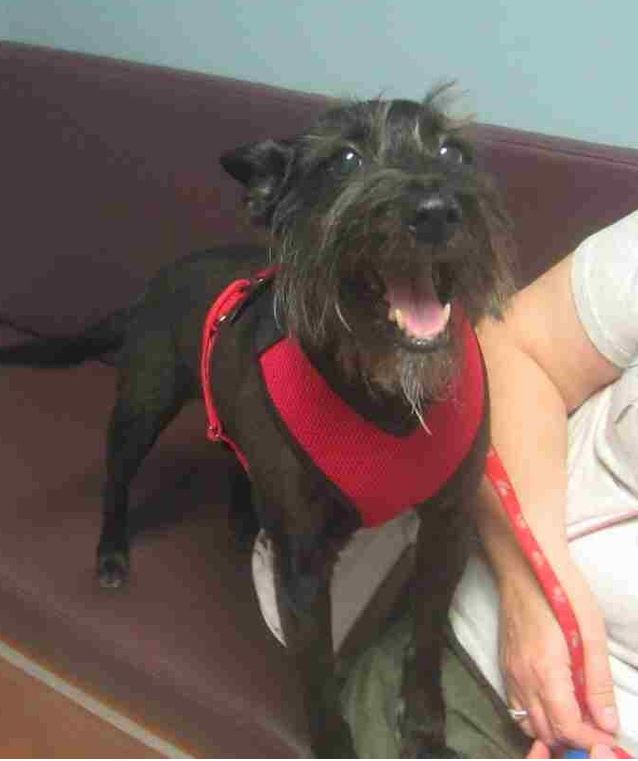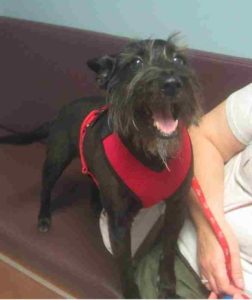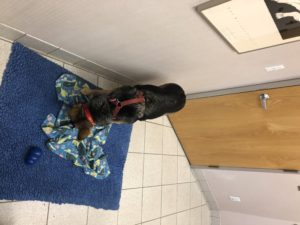Kim Campbell Thornton
Reducing fear, anxiety, and stress during visits and procedures takes time, teamwork, and sometimes a little experimentation. Here are three success stories shared by a veterinarian, trainer, and owner.

Kim Campbell Thornton
Reducing fear, anxiety, and stress during visits and procedures takes time, teamwork, and sometimes a little experimentation. Here are three success stories shared by a veterinarian, trainer, and owner.
Tyson is a 12-year-old Schnauzer mix who first came to us last year for a wellness visit. The owner told us that his previous clinic had to muzzle him, and he was handled somewhat roughly. She wanted to get away from that. On his first visit we just got a feel for his comfort level. He barked and growled at us in the room but took treats willingly. He allowed an otoscopic exam but was tense, and when the stethoscope was introduced, he actively tried to bite. Approaching him with a muzzle sent him into a panic. We sent some Trazodone home with him that day for future visits and discussed doing a set of behavioral visits to help desensitize him to handling and instruments.
owner told us that his previous clinic had to muzzle him, and he was handled somewhat roughly. She wanted to get away from that. On his first visit we just got a feel for his comfort level. He barked and growled at us in the room but took treats willingly. He allowed an otoscopic exam but was tense, and when the stethoscope was introduced, he actively tried to bite. Approaching him with a muzzle sent him into a panic. We sent some Trazodone home with him that day for future visits and discussed doing a set of behavioral visits to help desensitize him to handling and instruments.
Tyson returned five months later for scheduled vaccinations. With Trazodone on board he was still on edge but performed tricks for us and approached us for treats. He allowed me to auscult him while he had treats to eat. This was great progress! We still decided to sedate for the remainder of his procedures to avoid backtracking on his progress.
Over the course of the next year Tyson’s owner took her own Fear Free steps at home, buying her own grooming table and clipping him herself. She was patient with him and even learned to Dremel his nails.
When it was nearly time for Tyson’s annual exam she set up behavioral sessions with us, so we could work on desensitization. We discovered Trazodone made him a little grumpy at home, so we switched to gabapentin, which worked well for him. On his first behavioral visit the difference was obvious. He came right up to staff for treats, did all of his tricks, and allowed us to touch him everywhere. We could feel his belly, touch his ears and legs, and look in his mouth. We started doing mock injections with a capped needle with no reaction. The only thing that still triggered him was obvious restraint.
For his annual wellness visit, Tyson allowed a full exam. We applied topical lidocaine at his injection sites and where we planned to draw blood for a heartworm test. We put a donut collar on Tyson prior to his vaccines as a precaution, and asked the owner to hold his harness to keep him steady (he was really into the treats and a bit wiggly). He did not react to his vaccinations and even held still long enough for us to get a blood draw from his back leg.
Tyson made a huge turnaround, and I think the owner’s willingness to do her part played a big role. It has been great to see the difference Fear Free techniques have made!
Susan Sappington, DVM, Rock Bridge Animal Hospital, Columbia, Missouri
Elke had her annual veterinary checkup yesterday, and by doing some simple things we were able to make her visit less stressful and even a bit enjoyable. Our veterinarian is part of a Fear Free practice (Thank you, Animal Hospital of North Asheville) and embraces a cooperative care approach that allows animals to have choices and dictate the pace at which we move through the visit.
able to make her visit less stressful and even a bit enjoyable. Our veterinarian is part of a Fear Free practice (Thank you, Animal Hospital of North Asheville) and embraces a cooperative care approach that allows animals to have choices and dictate the pace at which we move through the visit.
In the photo, you see that there is a comfortable mat for Elke to use. Having a soft spot to rest on is so much nicer for dogs than just having the cold, hard floor. She was a bit nervous, so we created a treat search for her by hiding treats in the blanket and Kong. It is one of her favorite things to do, and sniffing is an activity that we know helps calm dogs. During the actual exam, all of us (veterinarian, veterinary technician, and myself) gave her treats each time a new body part was examined. While Elke does not love going to the veterinarian’s office, with cooperative care and the Fear Free method she was able to relax and have a calm visit.
Joann Rechtine, CPDT-KA, MS, MPH, RN, The Loose Leash Academy, Black Mountain, North Carolina
 We were beside ourselves on how to handle taking Roger to the vet. We put him through basic obedience and advanced obedience classes twice to learn manners and how to act appropriately. He has done great in our home and in our families’ homes as we know how to handle his anxiety. In our vet’s office, though, Roger would go crazy as his anxiety shot through the roof from all the smells and people. Thanks to the Fear Free program and team at Frey Pet Hospital, Roger can feel safer and happier going to the vet now. We are thankful for Fear Free Way!
We were beside ourselves on how to handle taking Roger to the vet. We put him through basic obedience and advanced obedience classes twice to learn manners and how to act appropriately. He has done great in our home and in our families’ homes as we know how to handle his anxiety. In our vet’s office, though, Roger would go crazy as his anxiety shot through the roof from all the smells and people. Thanks to the Fear Free program and team at Frey Pet Hospital, Roger can feel safer and happier going to the vet now. We are thankful for Fear Free Way!
Nicole Schroeder, Cedar Rapids, Iowa
This article was reviewed/edited by board-certified veterinary behaviorist Dr. Kenneth Martin and/or veterinary technician specialist in behavior Debbie Martin, LVT.
Action Required! Your Membership has expired
Renew yourself by clicking Renew on My Homepage
Team Members, please tell your Team Admin
Students, apply here to renew your membership
Why?
Renewing and keeping an active membership is one of the requirements to maintaining your certification as well as access to member benefits.
Need help? Please contact our Customer Experience team at wags@fearfreepets.com or call us at 303.952.0585 and we will be happy to assist!
Go to My Homepage
Action Required: You Were Removed from Your Fear Free Team
Update account information by clicking here to go to your account info.
Please note: If you were recently removed from your Fear Free team, your membership will either expire 90 days from the removal date or expire at your current membership renewal date, whichever comes first. Already renewed? Update your account information through the link above. You will continue to receive this notice until your company information has been updated.
Need to join a different Fear Free team or have questions?
Please contact our Customer Experience team at wags@fearfreepets.com or call us at 303.952.0585 and we will be happy to assist!
Go to My Homepage